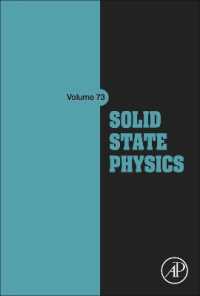- ホーム
- > 洋書
- > 英文書
- > Architecture
基本説明
The practice of architecture after the breakdown of consensus: designers, critics, and scholars consider architecture's divergent ideological landscape in this issue of America's oldest and most distinguished student-edited architectural journal.
Full Description
The practice of architecture after the breakdown of consensustheoreticians, and scholars consider architecture's divergent ideological landscape in this issue of America's oldest and most distinguished student-edited architectural journal.The profession of architecture is increasingly characterized by divergent architectural ideas and divergent political, social, technological, and economic agendas. Much of current practice focuses on the process of architecture (its how) rather than its meaning, effect, or reason for being (its why). This issue of Perspecta-the oldest and most distinguished student-edited architectural journal-explores the practice of architecture after the breakdown of consensus. Designers, theoreticians, and scholars investigate an architectural landscape devoid of a dominant ideology or ethos. Their essays take specific points of departure-globalization, urbanism, pedagogy, irony, as well as form, theory, and ideology-to address broader questions about the social, economic, and political fallout from these modes of practice, considering whether the lack of an overriding ethos in architecture is liberating or limiting for the profession. And, after all, is it conceivable, or desirable, to return to an architecture derived from a single, dominant mode of operation?ContributorsAuthors: Roger Connah, Winka Dubbeldam, Dawn Finley + Mark Wamble, Christopher Hight + Chris Perry, Sam Jacob, Emmanuel Petit, Michael Speaks, Ashley Schafer, Noriyuki Tajima, Tom Wiscombe, Lebbeus Woods, Stanley TigermanRoundtable participants: Michael Speaks (moderator), Hernan Diaz Alonso, Winka Dubbeldam, Mark Goulthorpe, Gregg Pasquarelli, David Serero








